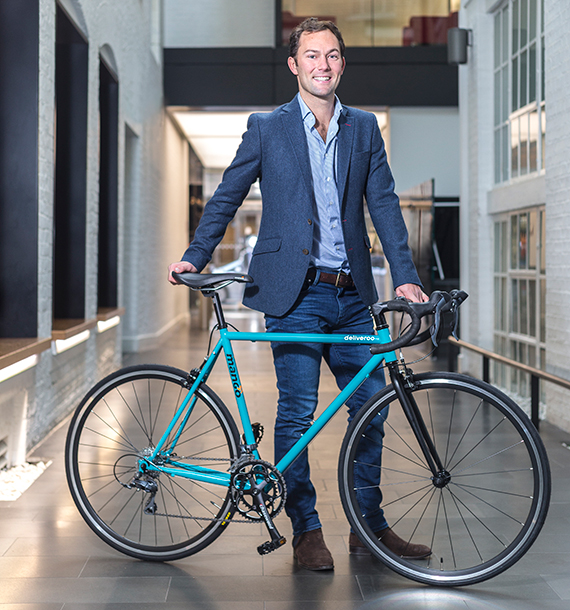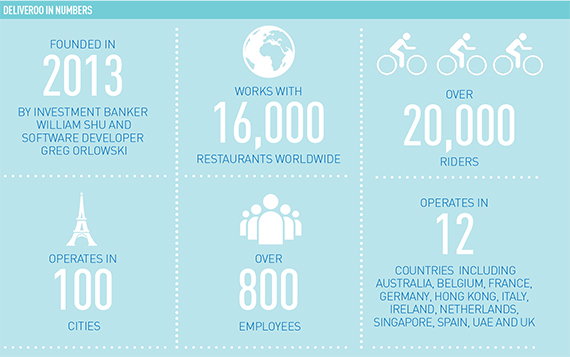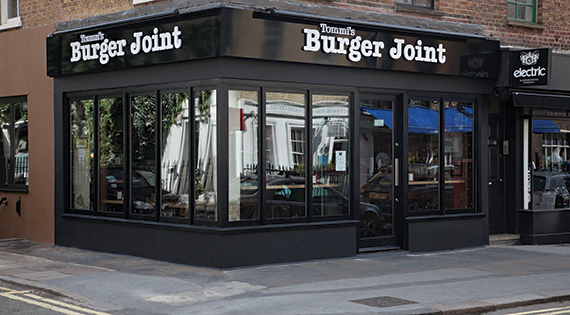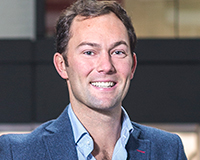It has brought high street restaurants to people’s front doors. Now Deliveroo is looking to combine property and technology with a new venture. Amber Rolt meets the man using data to help its partners manage demand and expand. Portrait by Kalory Photo & Video
The chefs at Tommi’s Burger Joint on King’s Road, SW3, are under pressure. Customers queue outside, seating is limited, turnover is rapid and demand is surging.
 But for hungry fans fortunate enough to live within a two kilometre radius of one of its restaurants, there is no need to queue, no need to fight for a table and no need to wait to be served. They can order with the click of a button through food delivery app Deliveroo.
But for hungry fans fortunate enough to live within a two kilometre radius of one of its restaurants, there is no need to queue, no need to fight for a table and no need to wait to be served. They can order with the click of a button through food delivery app Deliveroo.
Great news for Tommi’s when it comes to raising its profile. But, until recently, there was one major problem. With just two branches and a rapidly growing fan base fuelled by social media, it was struggling to keep up with demand.
Tommi’s growing popularity but limited space left it in a position where it had bitten off more than it could chew. Then, in May, it became one of the first restaurants in London to partner with Deliveroo to open surplus kitchen space through its new RooBox concept.
A bricks-and-mortar service, RooBox uses Deliveroo’s database to calculate where has the most demand for a brand’s product, and offers restaurants surplus kitchen space to keep up with growing takeaway orders.
Tommi’s new 200 sq ft of kitchen space in Battersea, SW11, has given it the capacity to double its delivery capabilities.
The system is a prime example of how the property and tech worlds can work better together. And Deliveroo cemented its commitment to the concept this summer, hiring Grosvenor’s retail leasing manager Charlie Farr to lead the RooBox concept and help bridge the gap between the two industries.
Now, just four months into his role as property acquisitions manager, the 29 year old reveals how he will connect Deliveroo’s database and restaurant contacts with landlords across London and the UK.
Transforming property
Farr brings with him a wealth of niche property knowledge. It is this, coupled with Deliveroo’s vast data capabilities, that have put him at the forefront of an innovative tech-based business platform trying to fuse the property and tech worlds in a way that no one has attempted before.
“Coming to work at a tech company is very different to my previous role, but bringing my property experience to Deliveroo is not something that everyone would associate together, but it is going to be at the forefront of our expansion,” he says.
So how exactly does the RooBox system work? Farr insists it is not looking to take on the restaurant industry, but partner with it. Its expansion will offer the company’s partner restaurants the use of fully equipped off site kitchens to be used as delivery hubs.
There are already nine operational RooBox sites in London, in Battersea and Dulwich, SE22, and this figure is set to increase dramatically over the coming year.
Though Farr won’t be drawn on just how much space the group intends to add to its RooBox portfolio, Deliveroo is already in discussion with landlords Hammerson, British Land and Land Securities on how to take the concept nationwide.
The flexibility of the RooBox concept means that its site requirements are fluid – all it needs is access to power, water and drainage. This opens up an opportunity to landlords sitting on car parks, service yards and development sites to generate income from otherwise redundant land.
It will be looking to acquire existing commercial kitchen space from non-profitable sites in restaurant portfolios as well as former kitchen space from restaurants that have gone into administration.
One of the first RooBox kitchens was set up in Deliverance’s kitchen facilities – an online restaurant service which fell into administration earlier this year.
 Deliveroo takes on the upfront cost of acquiring and fitting out the site as well as covering the rent and all negotiations and licensing agreements with the landlord. It then takes a proportion of sales made by the restaurant it is servicing. Leases can range from six months to five years and rental margins are flexible depending on the quality of space on offer.
Deliveroo takes on the upfront cost of acquiring and fitting out the site as well as covering the rent and all negotiations and licensing agreements with the landlord. It then takes a proportion of sales made by the restaurant it is servicing. Leases can range from six months to five years and rental margins are flexible depending on the quality of space on offer.
“What we are offering is a flexible and investment-free solution to be able to test new locations with minimal risk, because we take on the risk for them,” says Farr.
The model works for established brands looking to test the market in proposed areas of expansion and new concepts looking to assess their popularity in certain areas before committing to a permanent site.
“If a restaurant has two sites in London and is looking to expand, what we can do is look at our data and find where the brand will be most successful by looking at demand, spend, and population,” says Farr. “We can use our data to see exactly where a brand will be most suitable to test different markets.
“The brand can then go on to acquire bricks and mortar sites in areas that are successful.”
“Predominantly my role is finding these sites and negotiating deals with institutions as well as smaller, independent landlords. It is as important as it is with the restaurant partners that we partner with the right landlord partners so that we can build scale in lots of different locations,” he says.
Informed decisions
Data is at the core of all of Deliveroo’s decision making and property is no different. It will dictate where the company opens RooBox sites.
With EU referendum-related uncertainty prompting the market to soften, as well as the upcoming impact of business rates on the horizon, Farr says it will be more important than ever for the property industry and leisure occupiers to embrace tech to ensure they stay ahead of
the game and continue to generate income during difficult times.
“We make informed decisions based on the data that we have and I think property is perhaps lagging behind and needs to speed up with that, which I think it is,” he says. “But it is not entirely the case with all property companies. Property is still very much built on the contacts that you have in the industry, and at a lot of the big landlords there is still an old guard sitting at the top. My generation has to adapt to technology a lot more because that’s the future, and that analysis of data will become a lot more important in making decisions.”
But not all property companies have access to the same level of data as a tech giant like Deliveroo. Even in cases where they do, unless they have a dedicated analytics team, it is unlikely that they will be able to use data on a daily, decision-making
basis.
This is where Farr thinks that property companies and tech companies should work more closely together.
“Occupiers and landlords are always looking for new ways to digitise the experience of an estate, a shopping centre, or a high street,” he says. “And this is going to become more and more important to really understand exactly why people are returning to certain locations.
Embracing technology
And there are more benefits to embracing technology than just being able to make more informed decisions. The leisure sector in particular can benefit from technology to enable flexibility and the management of shorter leases to respond to occupier demand.
“What’s happening
generally at the moment is that 10-15 year leases are
not in as high demand and are not being frequently taken, apart from in prime spaces, and that’s because occupiers want flexibility,” says Farr.
Restaurants have now also begun to think more carefully about the location and accessibility of the sites so that they can work better with delivery platforms. Many high street restaurants have started to struggle with delivery access – with only one entrance it can be difficult to accommodate the volume of external takeaway orders as well as eat-in customers.
“Not all operators are set up for doing delivery, and we are already getting feedback from a lot of leisure occupiers that are looking to incorporate Deliveroo stations within their stores so they can still operate a customer focused restaurant as well as an efficient delivery system,” Farr says.
“We are definitely getting feedback from both landlords and agents that it is going to be more important for leisure occupiers to consider how they can effectively drive the margins on their delivery business.
This is something that leisure property agents will need to start thinking about too when helping brands with their expansion.
“I think that it is still an area which is transitioning to them,” says Farr. “Speaking to agents in the market it is something that they are more aware of and it is something that they are going to need to consider when moving into the future.”
Online influence
The online/offline rhetoric has dominated the retail industry in recent times, and the fear associated with the rise in online and its potential damage to physical sales has now infiltrated the leisure market too.
But, as Tommi’s 2,000 Instagram followers and booming sales figures show, this is not something that the property industry should be afraid of.
If anything, the Instagram followers, market data and growing consumer awareness through apps like Deliveroo are only going to help business, and in turn fuel further physical expansion.
As Farr’s new position shows, this is a deal that works both ways, and combining tech and property expertise in this way looks set to be a winning formula. While the rest of the market faces uncertainty, tuning in to the value of tech could be a safeguard to any business, particularly in the leisure sector.
As one of the first in the industry to ride both the property and tech waves at once, Farr’s advice should not go unnoticed: “It is really important for landlords to be considering this and be open to technology rather than shut it straight off.”
 Tommi’s burger joint
Tommi’s burger joint
Tommi’s Burger Joint has restaurants on King’s Road, Chelsea, SW1, Thayer Street, W1, and a Soho site coming soon, with RooBox space in Battersea.
Valgard Sorensen, owner, says: “RooBox offers our business a fantastic opportunity to promote itself in areas beyond our normal reach. We are able to offer a quality menu to a new market without the risks of committing to another location. It has enabled us to test a local market and make informed business decisions.”
Siggi Gunnlaugsson, head chef, says: “Deliveroo has provided us with a fully equipped and well-sized space through which we can produce our signature quality food with ease. We are able to use RooBox just like our regular kitchen. It’s easy to manage and we are now able to focus specifically on cooking for delivery, without the additional work streams like house service.”











